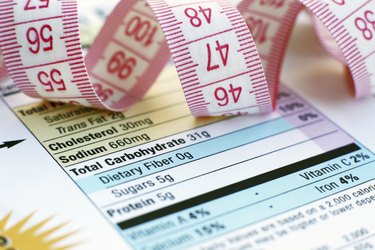
Before starting any weight loss plan, it is important to sit down and assess reasonable and effective nutritional goals. The key to long-term weight loss and maintenance is a balanced diet that incorporates all five food groups and provides the body with fuel and adequate nutrition. You can set reasonable calorie, protein, fat, carbohydrate and fiber goals that will be sustainable for a lifetime.
Step 1
Determine the amount of calories needed on a daily basis to maintain your weight. Use an online calorie calculator to help figure this out. (See Resources.) The calculator will ask for your height, weight, gender and physical activity amount.
Video of the Day
Step 2
Take your daily calorie total and subtract between 250 and 1,000 calories. This will be your weight loss calorie goal. A 250-calorie reduction will produce a 1/2-lb. loss a week. A 500-calorie reduction will produce a 1-lb. loss a week. A 1,000 calorie reduction will produce a 2-lb. loss a week.
Step 3
Calculate the amount of your daily calories that should come from carbohydrates. According to the Institute of Medicine's Acceptable Macronutrient Distribution Range (AMDR), 45 to 65 percent of calories should come from carbohydrates.
Take your weight-loss calorie level and multiply by a number between .45 to .65, which is reflective of the 45- to 65-percent goal. This is the number of calories that should come from carbohydrates. To convert into grams of carbohydrates divide the calories by 4. For example, 1,200 calories X .45 = 540 calories from carbohydrates daily. 540 calories from carbohydrates / 4 = 135 g of carbohydrates daily.
Step 4
Compute your amount of daily fat calories. Despite all the low-fat claims to weight loss, the AMDR for fat is 20 to 35 percent of daily calories.
Multiply your weight loss calorie level by .20 to .35 to find the amount of calories needed from fat. To find the daily grams, divide the calories by 9. For example, 1,200 calories X .25 = 300 calories from fat daily. 300 calories from fat / 9 = 33 g of fat daily.
Step 5
Determine your amount of daily protein calories. Protein is integral for weight loss, muscle building and satiety. Based on the AMDR, protein should contribute 10 to 35 percent of total calories.
Multiply your weight loss calorie level by .10 to .35 to find the amount of calories needed from protein. To find the daily grams, divide by 4. For example, 1,200 calories X .30 = 360 calories from protein daily. 360 / 4 = 90 g of protein daily.
Step 6
Calculate the amount of fiber you need daily. The Institute of Medicine recommends 25 g and 38 g of fiber daily for women and men under the age of 50, respectively, or approximately 14 g of fiber for every 1,000 calories consumed. Add fiber into your diet gradually and drink plenty of water.
For example, a 1,200-calorie diet would need to provide at least 18 g of fiber each day.
Tip
Your percent of total calories from all three energy sources should add up to 100. Do not choose the highest or lowest percentages from all three categories, as this would produce too many or too few total calories. For example, 45 percent from carbohydrates, 25 percent from fat, and 30 percent from protein totals 100 percent of your energy needs.
Write down all your nutrition goals. Keep them in a diary, planner or on your refrigerator as a daily reminder.
Some individuals may benefit from a multivitamin supplement. Check with your physician before starting any weight loss program.
Warning
For optimal long-term results, the National Institutes of Health do not recommend losing weight at a rate faster than 2 lb. each week.
The AMDR recommendations for calculating calories, carbohydrates, fats, protein and fiber are only for adults (over 18 years of age).
Fiber recommendations are very different from person to person. You may need more or less than the equation provided in this article.
Do not overly restrict your calories. A calorie restriction below 800 should always be supervised by a physician or dietitian.
Video of the Day